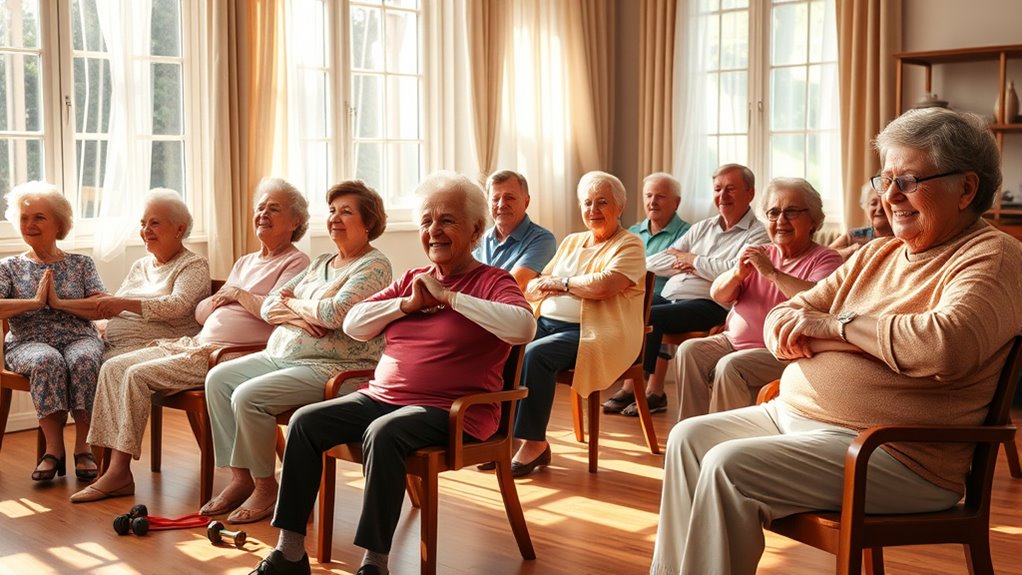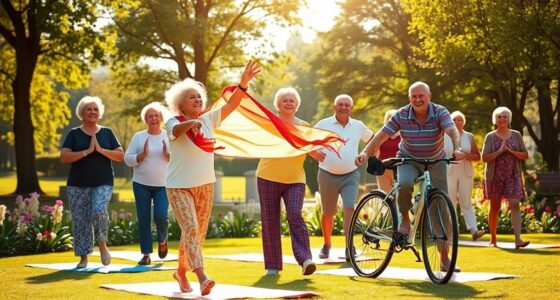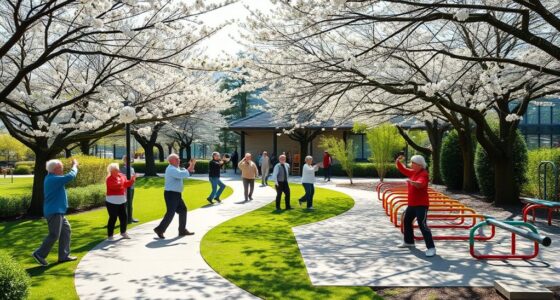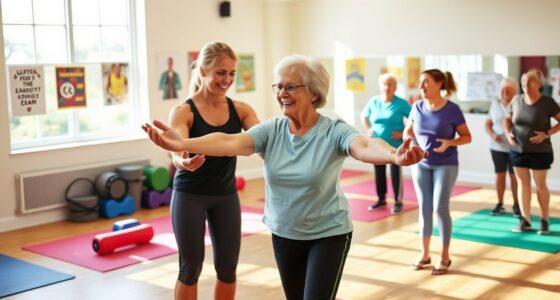Seated exercises are perfect for boosting your strength and mobility without the need for extensive movement. These simple routines can enhance flexibility, improve balance, and reduce fall risk, making them safe and effective for seniors. Focus on warming up and cooling down properly to maximize your workout. Incorporate neck, shoulder, and arm exercises, as well as hip and lower body movements, to achieve big gains in your overall well-being. Discover more beneficial techniques and ideas to enhance your routine.
Key Takeaways
- Seated exercises enhance mobility, strength, and flexibility, making them ideal for seniors with limited mobility.
- Incorporate gentle arm curls and shoulder rotations to strengthen upper body muscles and improve posture.
- Utilize hip circles and seated leg lifts to boost lower body flexibility and stability.
- Warm-up and cool down routines are essential for reducing injury risk and promoting relaxation.
- Engage in deep breathing exercises to lower stress levels and enhance overall well-being during workouts.
The Importance of Seated Exercises for Seniors
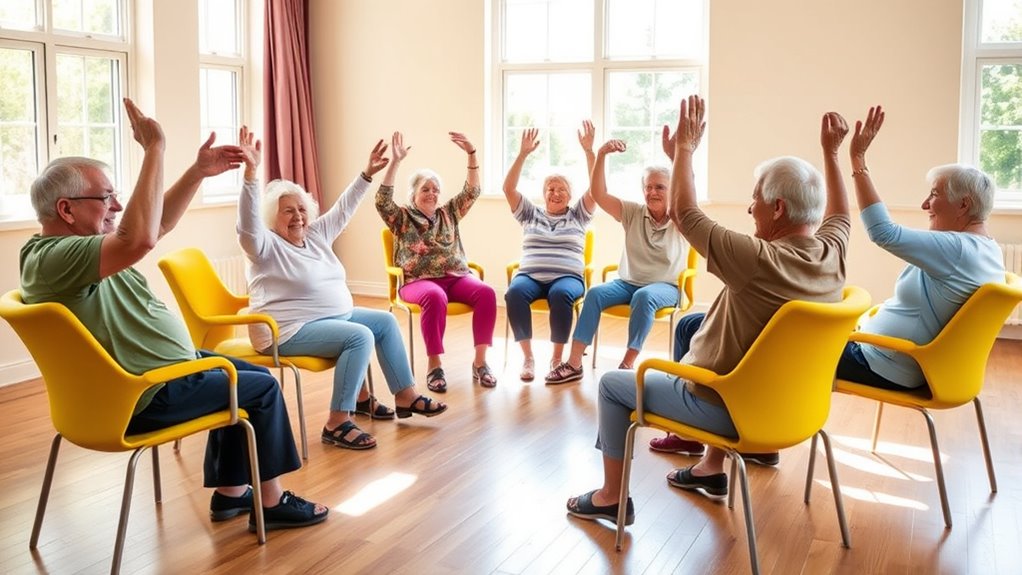
As you age, staying active becomes increasingly important, and seated exercises offer a safe way to enhance your mobility, strength, and flexibility. These exercises are particularly beneficial for seniors with limited mobility, allowing you to engage in physical activity without the strain of standing or walking. By incorporating seated exercises into your routine, you can greatly reduce the risk of falls, as they improve your balance and coordination. Additionally, understanding the legal guidelines for maintaining your health can help in creating a balanced exercise routine tailored to your needs. Engaging in regular physical activity can also help alleviate the effects of stress and emotional challenges that seniors may face. Make sure to include movements that challenge your strength, like raising one leg at a time, to build muscle and boost your overall health. Furthermore, creating transformative spaces that support your exercise routine can enhance your comfort and motivation. Additionally, participating in group classes can foster social interaction, promoting not just physical well-being but also mental wellness. Staying active is crucial for maintaining your independence as you age. Furthermore, understanding the importance of hydration is essential, as it helps in reducing fatigue and enhancing overall vitality during exercises. It’s also vital to consider your dog’s health and wellness needs, as a healthy pet can encourage you to stay active through walks and play.
Warm-Up and Cool Down Techniques

Before you start your seated exercises, warming up is essential to prepare your body and enhance relaxation. Simple movements like shoulder rolls and deep breathing can activate your muscles and improve circulation. Engaging in these techniques can also promote mental wellbeing, which is vital for overall health. Additionally, acknowledging your feelings during this process can aid in emotional healing, providing peace of mind as you engage in physical activities. According to the principles of the Law of Attraction, focusing on positive emotions can further enhance your exercise experience. After your workout, cooling down with gentle stretches helps alleviate tension and keeps you mobile. Additionally, incorporating mindfulness practices during your warm-up can further enhance your overall relaxation and focus.
Importance of Warm-Up
Warm-up exercises are essential for getting your body ready for physical activity, especially as we age. They help increase blood flow to your muscles and notably reduce the risk of injury. Simple routines like shoulder rolls and ankle circles can enhance your flexibility and promote better mobility. Additionally, cold medications can sometimes affect exercise performance, so it’s important to consider their impact if you’re taking them. Engaging in a warm-up can also help improve your overall credit score by fostering a healthier lifestyle that may reduce medical expenses. Including portable camping toilets in your outdoor activities can lead to a more comfortable experience, particularly for those who may struggle with mobility. Moreover, individuals with conditions like BPD may find that warm-up routines help ease emotional regulation challenges during physical activity.
Aim for a warm-up session that includes dynamic movements gradually increasing in intensity. This approach allows for a smoother shift into more strenuous exercises, making your workout safer and more effective. Additionally, incorporating expert advice on tailored warm-up routines can further enhance your exercise experience.
Benefits of Cool Down
After completing your seated exercises, it’s just as important to incorporate a cool down into your routine.
Cooling down helps gradually lower your heart rate, reducing the risk of dizziness or fainting. During this phase, focus on deep breathing to promote relaxation and increase oxygen flow to your muscles, aiding in recovery. Additionally, just as solar panels need to be cleaned for optimal performance, keeping your body relaxed and well-cared for post-exercise is essential for recovery. Air purifiers with HEPA filters can significantly enhance indoor air quality, making your recovery environment more beneficial. Furthermore, incorporating glycolic acid into your skincare routine can help enhance skin hydration, which is beneficial for overall recovery. Maintaining a clean environment with air purifiers can also help reduce allergens that may interfere with your recovery process.
Gentle stretching can alleviate muscle tension and improve flexibility, helping to prevent injuries in future workouts. A proper cool down also flushes out metabolic waste products, which can help prevent soreness and stiffness.
Engaging in slow, controlled movements encourages mindfulness and enhances your overall sense of well-being. By including a cool down, you set yourself up for better recovery and a more enjoyable exercise experience, similar to how regular cleaning of air purifiers can maintain optimal performance and air quality.
Neck, Shoulder, and Upper Back Mobility

To improve your neck, shoulder, and upper back mobility, it’s important to incorporate specific exercises into your routine. Simple neck flexibility techniques, like side looks and chin tucks, can relieve tension and enhance your range of motion. Additionally, understanding the importance of advance directives can provide peace of mind as you maintain your physical health. Regular physical activity, including health benefits of clean homes, can further support your overall well-being and mobility. Engaging in community events can also help create supportive connections that encourage consistent movement. Moreover, developing cultural intelligence in your interactions can enhance your confidence and communication with others, facilitating a more supportive environment for exercise. Along with shoulder strengthening exercises, these moves will help you perform daily tasks with greater ease and confidence. Additionally, engaging in holistic living practices can further support your overall well-being and mobility.
Neck Flexibility Techniques
As you age, maintaining neck flexibility becomes essential for overall mobility and comfort. Incorporating gentle movements into your routine can greatly enhance your neck’s range of motion without causing strain.
Here are some effective techniques:
- Side-to-Side Turns: Look left and right, holding each position for a moment. Aim for five repetitions.
- Chin-to-Chest: Lower your chin toward your chest and then look up towards the ceiling, repeating this five times.
- Shoulder-to-Neck Stretch: Bring your ear down to your shoulder, alternating sides with five repetitions on each side.
Remember to keep your shoulders back and core tight while performing these exercises.
Consistent practice can reduce stiffness, improve posture, and contribute to overall upper body mobility.
Shoulder Strengthening Exercises
While you may not realize it, strengthening your shoulders is essential for maintaining overall upper body mobility and stability as you age. Engaging in shoulder exercises enhances your posture, which can help prevent falls.
Focus on maintaining an upright posture while bringing your arms to 90 degrees and performing gentle rotations. Incorporate arm curls and shoulder extensions to increase strength and flexibility, making daily tasks easier.
Don’t forget to include mobility routines, like pulling your arms back and squeezing your shoulder blades together, to boost circulation and reduce stiffness.
Consistently performing these exercises leads to significant gains in shoulder strength, allowing you to navigate your day-to-day life with greater ease and a lower risk of injury.
Strengthening Arms and Core
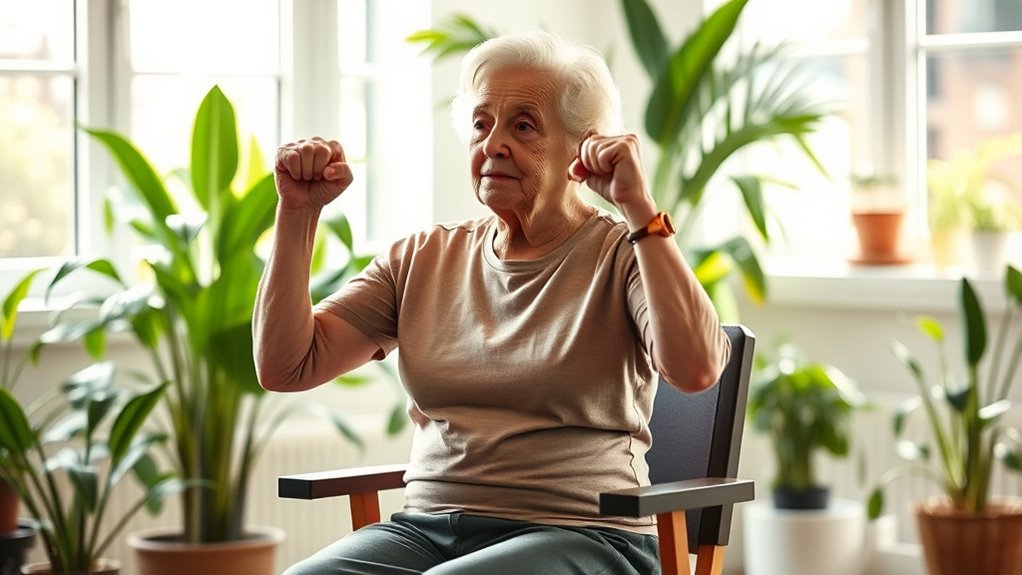
Strengthening your arms and core is essential for enhancing overall mobility and independence as you age. Engaging in seated exercises can effectively boost your upper body strength, making daily tasks easier and safer.
Strengthening your arms and core through seated exercises enhances mobility and independence as you age.
Focus on controlled movements to improve muscle endurance and stability, which are key for maintaining balance.
- Back arm curls: Strengthen your biceps and triceps for better upper body function.
- Controlled sit-back exercises: Enhance core stability to reduce the risk of falls.
- Seated push-ups: Improve upper body strength and mobility, promoting better posture.
Hip, Knee, and Lower Leg Exercises

Incorporating hip, knee, and lower leg exercises into your routine can make a significant difference in your mobility and balance.
Start with hip circles and abductions to enhance your hip mobility and maintain independence. For strengthening your knees and lower legs, try seated leg lifts and hamstring stretches to boost flexibility.
Don’t forget ankle pumps and toe lifts; these exercises improve calf strength and circulation, which can reduce the risk of blood clots.
Regularly practicing these lower body movements can enhance your stability and coordination, helping to prevent falls.
By including these exercises in your daily life, you’ll enjoy increased functional mobility and be able to engage more actively in various activities.
Your independence is worth the effort!
Enhancing Balance and Coordination
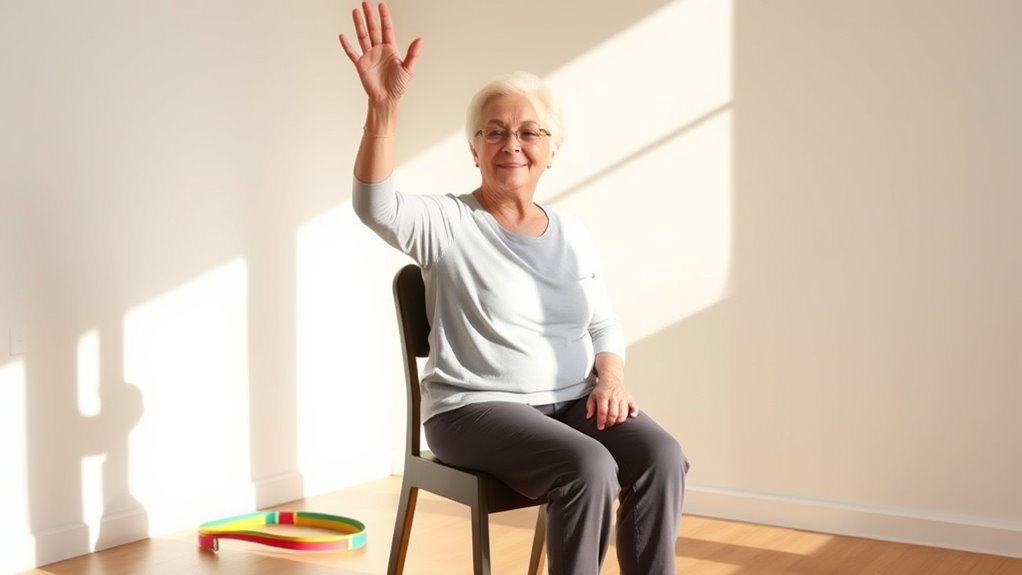
To enhance balance and coordination, engaging in seated exercises can be incredibly beneficial for you as you age.
These exercises not only strengthen your core but also improve your proprioception, which is essential for stability. Incorporating specific movements into your routine will help you maintain better balance during daily activities.
- Hip abductions and ankle pumps strengthen lower body muscles.
- Shoulder rolls and neck exercises increase upper body awareness.
- Sit-backs and side bends enhance flexibility and smooth changes between sitting and standing.
Relaxation Techniques for Stress Relief

As you navigate the challenges of aging, it’s essential to prioritize relaxation techniques that can effectively alleviate stress and promote well-being.
Deep breathing exercises are a great start, activating your body’s relaxation response and lowering cortisol levels, which fosters calmness. You might also try the body scan technique, focusing on different body parts to identify and release tension, enhancing mental clarity.
Regular practice of progressive muscle relaxation can boost your emotional health, reducing anxiety and feelings of depression. Incorporating gentle movements, like shoulder rolls and arm shakes, can further improve circulation and aid stress relief.
Incorporating Breathing Exercises
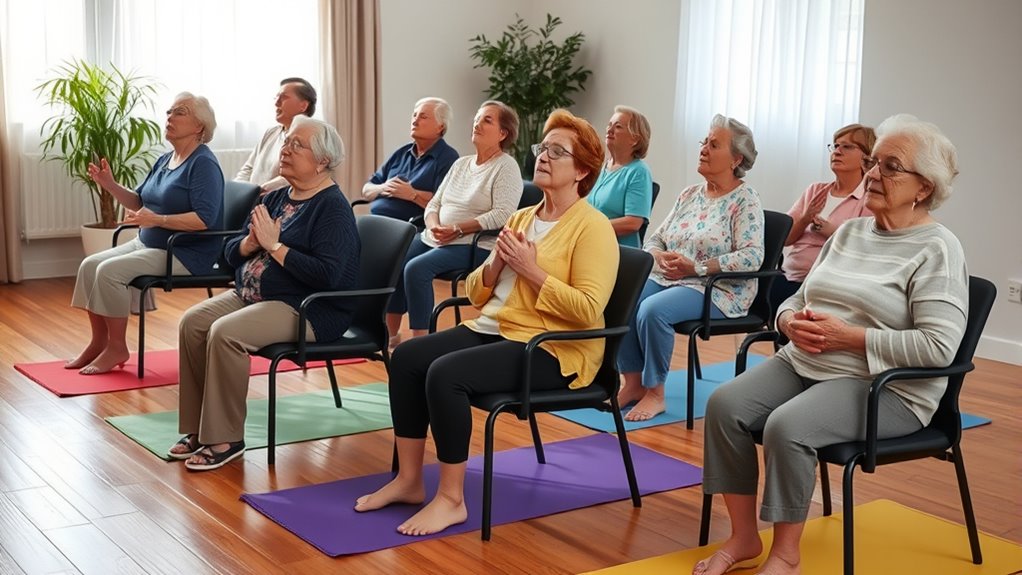
Breathing exercises can greatly enhance your seated workouts, making them not only more effective but also enjoyable. By incorporating deep breathing techniques, you can improve lung capacity and oxygen flow, which is essential for your overall health.
Controlled breathing encourages better posture and core engagement, helping you maintain stability and balance.
Here are some benefits of adding breathing exercises to your routine:
- Reduces stress: Promotes relaxation, making your physical activity more pleasant.
- Enhances coordination: Syncing your breath with movements fosters a stronger mind-body connection.
- Boosts energy: Regular practice improves mental clarity and reduces fatigue, allowing you to feel more energized during workouts.
Try these techniques to maximize your seated exercise experience!
Frequently Asked Questions
Do Seated Exercisers Work for Seniors?
Yes, seated exercises work for seniors! They’re designed to improve strength, flexibility, and balance without putting too much strain on the body.
You’ll find that these low-impact routines can enhance your cardiovascular health and overall well-being. By incorporating seated exercises into your daily routine, you can alleviate symptoms of chronic conditions and even boost your mental health.
What Is the Number 1 Exercise to Increase Balance in Seniors?
Imagine a tree swaying in the wind, its roots firmly planted.
The number one exercise to boost balance in seniors is the sit-to-stand. Just like that tree, you can strengthen your roots—your leg muscles—by rising from a seated position repeatedly.
This simple move targets key muscles, enhancing stability and reducing fall risks. Aim for 10 to 15 reps, a few times a week, and you’ll feel more grounded in your daily life.
Which Type of Exercise Is Most Strongly Recommended for Older Adults?
When it comes to exercising, aerobic exercises are most strongly recommended for you as an older adult. Activities like walking, cycling, or swimming boost your cardiovascular health and increase overall endurance.
Aim for at least 150 minutes of moderate-intensity aerobic activity each week. Incorporating strength training and flexibility exercises can further enhance your fitness and well-being.
What Is the AARP #1 Exercise for Seniors?
When it comes to staying active, you can’t teach an old dog new tricks—except with seated leg extensions!
The AARP’s top exercise for seniors, this move helps strengthen your legs while sitting comfortably. It’s all about improving mobility and reducing the risk of falls.
Conclusion
Incorporating seated exercises into your routine can make a world of difference for your health and well-being. You’ll not only improve strength and mobility but also boost your balance and coordination, keeping you on your toes. Remember, it’s never too late to start moving, and these easy moves can help you reap big rewards. So, take the plunge and embrace these exercises; after all, every little bit helps when it comes to staying active and feeling great!
